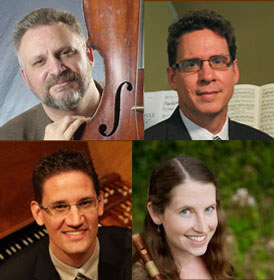The Raleigh Chamber Music Guild‘s Sights and Sounds on Sundays series tries to match chamber music programs with major visiting exhibitions. Few touring exhibits at the N.C. Museum of Art have had the national importance of its current “Rembrandt Paintings in America.”
Triad music lovers have been lucky to have the Magnolia Baroque Festival, a biannual celebration of baroque music in various venues in Winston-Salem. Founded in June 2005, the Festival always draws upon the local manuscripts of the Moravian Archives in Old Salem as well as the usual major composers. During its June festivals, Magnolia Baroque presents the finest regional and national musicians dedicated to historically informed performances. The festival occurs in off-years of the long-established Boston Early Music Festival, thus freeing the pool of potential artists for the Magnolia Festival. Choral and period dance performances are popular elements of the series.
Founder Glenn Siebert told a sold-out audience in the museum’s auditorium that Holland’s dominant Calvinist culture discouraged instrumental or major works in churches. Instead, most of the music during Rembrandt’s time was composed for performance by middle class families in private homes. Samples of songs and instrumental works were performed by tenor Siebert and Timothy Olsen, harpsichord, Anne Timberlake, recorder, and Brent Wissick, viola da gamba.
Jan Pieterszoon Sweelinck (1562-1621) was the only composer on the program likely to be known to many music lovers. Seibert and Olsen opened the concert with two songs, “Onder een Linde groen” and “Mein junges Leben hat ein End by Sweelinck,” followed by Olsen’s brilliant playing of sets of variations by the composer. Siebert drew attention to Olsen’s use of the right hand to create fascinating improvisations. Throughout the concert, Siebert read the songs’ translations before he sang each, and he or another player added brief cogent comments before each work was played. It must be admitted that none of the works were towering masterpieces. Instead these were pleasant musical numbers intended for home entertainment. (Music lovers and performers welcomed the early departure of some children far too young for concert going.)
Next Seibert sang four selections from Pathodia Sacra et Profana (1647) by Constantijn Huygens (1596-1687), a Dutch Golden Age poet and composer who was secretary to two Princes of Orange – Frederick Henry and William II. He was also the father of the famous scientist Christiaan Huygens. The two Italian songs were “Va donna ingrate” and “Sospir che del bel petto.” The two French songs were “Que ferons-nous” and “Quoy Clorinde tu pars.”
Brent Wissick joined harpsichordist Olsen to perform a composite four-movement piece drawn from two different Sonatas in A minor from the L’Echo du Danube, Op. 9, by Johannes Schenk (1660-1712). Wissick said the first and last movements reflected the Italian style of Corelli while the middle two reflected the fantastical German style. Wissick played with his usual warm tone, fine intonation, and great precision during fast passages. Olsen was very much an even partner.
Siebert next sang, “Come again,” one of the best known songs of the great English composer John Dowland (1563-1626), accompanied by Olsen. Siebert sang this as well as the rest of the songs on the program with a warm, winning timbre and a marvelously even voice across his whole range. His diction was immaculate. The Dowland selection was from the composer’s songs for voice and lute, so it was delightful to hear the rich lute-stop of Olsen’s harpsichord accompaniment. This served to introduce the remaining musician, Anne Timberlake, who played an extended set of variations on “Compagain” from Der Fluyten Lust-hof by Jacob van Eyct (1590-1657). Her baroque wood flute produced a wonderful tone and she played the challenging variations on the Dowland song brilliantly with fine breath control.
The concert ended with Siebert singing two songs, “Amarilli mia Bella” and “Courante Mars,” followed by more Van Eyct variations. This was a delightful concert and sampling of chamber music that might be heard at the summer festival. This sampler should tempt more Triangle baroque enthusiasts to the festival in Winston-Salem next summer.











